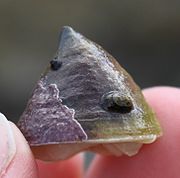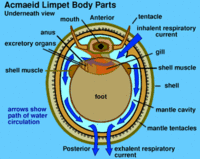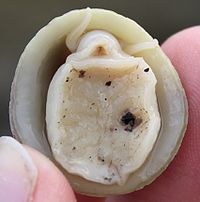Acmaea mitra
From ize2010
| Acmaea mitra | |
|---|---|
 |
|
| A live individual of Acmaea mitra. The shell is slightly covered in encrusting red Coralline Algae | |
| Scientific classification | |
| Kingdom: | Animalia |
| Phylum: | Mollusca |
| Class: | Gastropoda |
| (unranked): | clade Patellogastropoda |
| Superfamily: | Patelloidea |
| Family: | Lottiidae |
| Genus: | Acmaea Eschscholtz, 1833 |
| Species: | A. mitra |
| Binomial name | |
| Acmaea mitra Rathke, 1833 |
|
The Whitecap Limpet (Acmaea mitra), also known as the Dunce Cap Limpet, Bishops Cap Limpet, Chinaman’s Hat Limpet, and White-capped Limpet, is a small herbivorous] limpet belonging to a large group called Molluscs, and identified as a gastropod (which include snails, slugs, abalone and limpets).[1] It is one of few members in the genus Acmaea. [2]
Contents |
Behavior and General Characteristics
The Whitecap Limpet is a soft bodied univalve invertebrate. [3] It has a thick white shell that has usually been encrusted with pink Coralline Algae. The steep oval shaped shell, with a high conical apex set near the center of the shell, is typically between 1-2 inches (5 cm) in diameter. [4][1]
The Whitecap Limpet has a head (with a pair of long light-sensitive tentacles and a radula), a visceral mass (which are the internal organs protected by the mantle), and a strong muscular foot. Their strong muscular foot is the most visible part of their body, which ripples as they move (in cases such as grazing for algae). This large foot allows the Whitecap Limpet to suction to rocks, clinging very tightly. They should never be pried off of rocks since it could damage the function of this muscular foot. [3][2]

The Whitecap Limpet (which is considered a true limpet), has a single gill towards the anterior end of their bodies. Their internal organs (or visceral mass) are protected by a flap of tissue called the mantle which overhangs along the inside of the shell allowing for water current to run into the two symmetrical mantle grooves, at the anterior, through the mantle cavity and out the rear at the posterior. [5][6]
Ecology
The Whitecap Limpet is a herbivore. It feeds at night or day (depending on the time of year), when the tide is high, on marine algae and vegetation. More specifically algae like the pink encrusted Coralline Algae covering its shell, which is naturally white. They graze on algae using their tongue (or radula) which has tons of tiny teeth to scrap the algae off the surface. Both the Whitecap Limpet and Coralline Algae benefit from this symbiotic relationship since the limpet has a constant food source and the algae is kept clean and healthier. [7] When they tide begins to lower, the Whitecap Limpet returns to its home (or typical location) with a homing instinct. It is hypothesized that the limpet's homing ability could possibly be explained by chemical cues left behind while feeding. [7][3][5][2]
Reproduction
The Whitecap Limpets have separate male and female individuals. Their two functioning kidneys allow for the passing of the eggs or sperm. The gametes travel from the duct (extending from the gonad to the distal portion of the right kidney) down to the mantle cavity. Reproduction is done so externally, so their eggs release straight into the water, from the mantle cavity, allowing them to fertilize. At first they take the form of free-swimming larvae, but eventually populate and settle on the surface of rocks and seaweed. [7][2]
Distribution
The Whitecap Limpet is found along the coast of the Pacific Northwest (n. Alaska to n. Mexico) found low in the intertidal zones with a depth up to 60 m (200ft). [1] [4]
Predators
The predators of the Whitecap Limpet are birds, fish, starfish and people. They are fairly easy to hunt and catch since they travel at such a slow pace. Humans have been harvesting them for over 150,000 years. Although the most traditionally eaten limpet is the "opihi" limpet which is considered a delicacy in Hawaii. [8]
See also
References
- ↑ 1.0 1.1 1.2 1.3 Lamb, A and B Handy. 2005. "Marine Life of the Pacific Northwest". Harbour Publishing, British Columbia: 85
- ↑ 2.0 2.1 2.2 2.3 Ingram, J. 2007. "Life of a Limpet" (on-line), Comox Valley Naturalists Society. Accessed on May, 7, 2010 at http://www.comoxvalleynaturalist.bc.ca/knowing_nature/2007/limpet.html
- ↑ 3.0 3.1 3.2 Jeananda, C. 2000-2010. "Limpet"" (on-line), EnchantedLearning.com. Accessed on May, 7, 2010 at http://www.enchantedlearning.com/subjects/invertebrates/mollusk/gastropod/Limpet.shtml
- ↑ 4.0 4.1 Adams, M. 2006. "Acmaea mitra" (whitecap Limpet), Washington State University: Beach Watchers. Accessed on May, 7, 2010 at http://www.beachwatchers.wsu.edu/ezidweb/animals/Acmaeamitra.htm
- ↑ 5.0 5.1 5.2 Davey, K. (2000) "Molluscs - Limpets" (on-line) Life On Australian Seashores. Accessed on May, 7, 2010 at http://mesa.edu.au/friends/seashores/limpets.html
- ↑ Pechenic, J. 2010. "Biology of the Invertebrates: 6th Edition". McGraw-Hill Publishing, New York, NY
- ↑ 7.0 7.1 7.2 Merritt, A. "Limpets" (on-line). Accessed on 05, 20, 2010 at http://academics.smcvt.edu/dfacey/AquaticBiology/Coastal%20Pages/Limpets.html
- ↑ Chase, C., Chase, N. (1998) "Limpets" (on-line) Oregontidepools.com. Accessed May, 7, 2010 at http://oregontidepools.info/limpets.html


